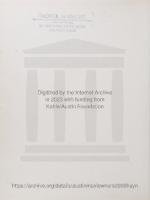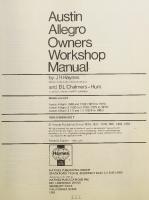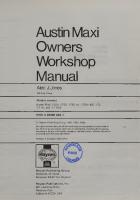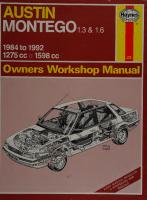Haynes Austin Metro Owners Workshop Manual 0856969788, 9780856969782
Haynes Austin Metro Owners Workshop Manual - John Harold Haynes - Haynes Publishing - 1984.
153 56 22MB
English Pages 200 [220] Year 1984
Recommend Papers
File loading please wait...
Citation preview
EDINBURGH Cl
IB
IES
raw
_ ¥ THIS BOOK MUST NOT BE REMOVED UNDER ANY PRETEXT FROM THE REFERENCE. DEPARTMENT. INFRINGEMENT OF THIS RULE RENDERS THE OFFENDER LIABLE TO PROSECUTION.
Before leaving the Library readers must return the books to one of the attendants at the issue desk, or they will be held responsible for them. Readers are required to take care of the books, Writing or drawing with pen or pencil on any part of a book, or turning down the leaves, or cutting or mutilating them, will be treated as serious damage.
q CONVERSATION IN THE REFERENCE DEPARTMENT IS ANNOYING TO STUDENTS, AND IS NOT
es A
bh
Vitro”
|UL
es
LIBRARIES
Owners
C'S
Wor ksh op Manual Kevee
AK Legg
mater
&UA
WY:
T Eng (CEI), AMIMI
Models covered: Austin mini Metro City, Standard, L, HLE and Van; 998 cc Austin mini Metro 1.3L, 1.3S, 1.3HL, 1.3HLE, 1.3HLS and Van; 1275 cc MG Metro and MG Metro Turbo; 1275 cc Metro Vanden Plas; 1275 cc
ISBN 0 85696 978 8 © Haynes Publishing Group 1981, 1984 All rights reserved. No part of this book may be reproduced or transmitted in any form or by any means, ced nic oraes ir including photocopying, recording or by”cy yyFog ak +. em, without permission
in writing from: ‘the refome
Printed in England
es: eo
(778-10J4)
HAYNES PUBLISHING GROUP SPARKFORD YEOVIL SOMERSET BA22 7JJ ENGLAND distributed in the USA by
HAYNES PUBLICATIONS 861 LAWRENCE DRIVE NEWBURY PARK CALFORNIA 91320
USA
INC
ABCOE xem
| CDIBURGH CITY LIBRARIES
Acknowledgements Thanks are due to BL Cars Limited for the supply of technical information. The Champion Sparking Plug Company supplied the illustrations showing the various spark plug conditions. Castrol Limited kindly supplied the lubrication data, and Sykes-Pickavant Ltd provided
About
some of the workshop tools. Special thanks are due to all those people
at Sparkford who helped in the production of this manual, and to Robin Wood of Evercreech, Somerset, for the loan of his MG Metro 1300.
this manual
[ts aim The aim of this manual is to help you get the best from your car. It can do so in several ways. It can help you decide what work must
It is freely illustrated, especially in those parts where there is a detailed sequence of operations to be carried out. There are two forms be done (even should you choose to get it done by a garage), provide of illustration: figures and photographs. The figures are numbered in information on routine maintenance and servicing. and give a logical sequence with decimal numbers, according to their position in the course of action and diagnosis when random faults occur. However, it Chapter — eg Fig. 6.4 is the fourth drawing/illustration in Chapter 6. is hoped that you will use the manual by tackling the work yourself. On Photographs carry the same number (either individually or in related simpler jobs it may even be quicker than booking the car into a 9 groups) as the Section or sub-section to which they relate. pee n alphabetical index at the back of the manual as well as and going there twice to leave and collect it. Perhaps mosty i. es t atfthe.front. Each Chapter is also preceded by its own a lot of money can be saved by avoiding the costs the g charge to cover its labour and overheads. individual coAtehts list. The manual has drawings and descriptions to show the function of References to the ‘left’ or ‘right’ of the vehicle are in the sense of the various components so that their layout can be understood. Then a person in the driver's seat facing forwards. the tasks are described and photographed in a step-by-step sequence Unless otherwise stated, nuts and bolts are removed by turning so that even a novice can do the work. anti-clockwise, and tightened by turning clockwise. Vehicle manufacturers continually make changes to specifications and recommendations, and these, when notified, are incorporated into /ts arrangement our manuals at the earliest opportunity. The manual is divided into thirteen Chapters, each covering a Whilst every care is taken to ensure that the information in this logical sub-division of the vehicle. The Chapters are each divided into manual is correct, no liability can be accepted by the authors or Sections, numbered with single figures, eg 5; and the Sections into publishers for loss, damage or injury caused by any errors in, or paragraphs (or sub-sections), with decimal numbers following on from the Section they are in, eg 5.1. 5.2 5.3 etc. omissions from the information given.
Introduction
to the Metro
The Austin mini Metro was first introduced in October 1980 and was initially only on sale to the UK market, export sales to the European market following in early 1981. The hatchback range of models covers a low compression fleet option, Standard and L versions, economy HLE version equipped with a 998 cc engine, and ‘L’, sport ‘S’ and luxury ‘HLS’ versions equipped with a 1275 cc engine. The body is of computer-based design and is assembled and welded by computer-controlled robots. The ‘A-Plus’ engine and gearbox assembly is similar to that fitted to the BL Mini range, although it is much improved, with durability and economy prime considerations. Drive is through the front wheels and the en-
gine/gearbox unit is fitted transversely across the front of the car. The most significant design characteristics are bolt-on front wings, self-cleaning distributor contact points, fully closed crankcase ventilation system, front-mounted aluminium radiator, dual circuit braking system, and Hydragas suspension. Instrumentation is comprehensive and includes a seat belt warning lamp, brake pad wear warning lamp, and handbrake warning lamp. Later additions to the Metro range include a luxurious Vanden Plas version, sporty MG and MG Turbo versions, and 1.0 and 1.3 Vans. Details of these models, and of modifications affecting later models generally, will be found in the Supplement
at the end of the manual.
Contents Page
Acknowledgements
About this manual
2
:
Introduction to the Metro
2 2
General dimensions, weights and capacities
7
Tools and working facilities
9
Jacking and towing
11
Recommended
13
lubricants and fluids
Safety first!
14
Routine maintenance
15
Fault diagnosis
18
Chapter 1
Engine
22
Chapter 2
Cooling system
43
Chapter 3.
Fuel and exhaust systems
50
Chapter 4
Ignition system
62
Chapter 5
Clutch
71
Chapter. 6
Manual gearbox and automatic transmission
78
Chapter 7
Final drive
Chapter 8
Driveshafts
101 106
ew i sa Braking system
111
Ghapter 10
Electrical system
123
Chapter 11
Suspension and steering
145
Bodywork and fittings
158
Chapter
. Chapter
9
12
Conversion Index
factors
eS
AQAA
NASR
LEANN AWWEARVARWN WEANEANNWAR
MEARS
Austin
Austin
mini Metro
mini Metro
1.3 HLS
1.3 HLS
es ia
E36
® 3
ES
Re
MG
Metro Turbo
SO
General dimensions, weights and capacities Dimensions Turning circle (between kerbs) WMO OND ASG aca sree catgeretas cucatvavendeahiasshestewuesebtinneteasasess Overall length:
33 ft 6 in (10.21 m) 7 ft 4.625 in (2.251 m)
All models except Vans MATA raspeater au seauvante seanavasathasussaei sicenuactin crores
11 ft 2.05 in (3.405 m) 11 ft 2.00 in (3.403 m)
Overall width (excluding mirrors): Pre-1983 models 1983 models Overall height: All 1.0 models, all Vans and MG Turbo
All 1.3 models except Vans and MG Turbo Ground
5 ft 0.875 in (1.546 m) 5 ft 1.18 in (1.554 m) 4 ft 5.5 in (1.360 m) 4 ft 5.875 in (1.368 m)
clearance:
Manual
transmission (early models)
Manual
transmission (later models)
Automatic
transmission
4.375 in (112 mm) 5.906 in (150 mm)
5.750 in (146 mm) 5.315 in (135 mm) minimum
Weights Kerb weights (approx, with full fuel tank): MiG i Oo City srr retectirnscatrceee-scactantuctvescucossneseessases Rey atom 8-238 2) Fen Bate ei Uli an
MietrosFill Esceitacrtreccccovercet secrete tects sctestacecssvsens Metro 1.3 HL and 1.3S Metro 1.3L and 1.3 HLS
Metro Automatic Maximum braked trailer weight (subject to local legislation): Metro 1.0 HLE Metro 1.0 Van All other 1.0 models Metro 1.3 Van Metro Automatic All other 1.3 models
Maximum
vehicle loading:
Passenger Metro 1.0 Metro 1.3 Maximum roof
vehicles Van Van rack load
Capacities (approx). Engine/manual gearbox oil (without filter) Oil filter (manual gearbox) Engine/automatic transmission oil (without filter) Oil filter (automatic transmission) Cooling system (including heater) Fhe lataainlG ae -seeeeaeete teas arise he pete eee mad asia
1594 1620 1632 1638 1646 1662 1695 1711 1852 1731 1773
Ib Ib Ib Ib Ib Ib Ib Ib Ib Ib Ib
(723 (735 (740 (743 (747 (754 (769 (776 (840 (785 (804
kg) kg) kg) kg) kg) kg) kg) kg) kg) kg) kg)
1433 1896 1874 1929 1433 2095
Ib Ib Ib Ib Ib |b
(650 (860 (850 (875 (650 (950
kg) kg) kg) kg) kg) kg)
705 794 882 106
Ib Ib Ib Ib
(320 kg) (360 kg) (400 kg) (48 kg)
8.5 pints (4.8 litres)
0.6 pint (0.3 litre) 8.8 pints (5.0 litres)
1.0 pint (0.6 litre) 8.5 pints (4.8 litres) 6.6 gallons (30 litres)
Buying spare parts and vehicle
identification
Buying spare parts Spare
parts are
available
from
many
sources,
for example:
BL
garages, other garages and accessory shops, and motor factors. Our advice regarding spare parts is as follows: Officially appointed BL garages — This is the best source of parts which are peculiar to your car and are otherwise generally not available (eg complete cylinder heads, internal gearbox components, badges, interior trim etc). It is also the only place at which you should buy parts if your car is still under warranty; non-BL parts may invalidate the warranty. To be sure of obtaining the correct parts it will always be necessary to give the storeman your car's engine number and chassis number, and if possible, to take the old part along for positive identification. Many parts are available under a factory exchange scheme — any parts returned should always be clean! It obviously makes good sense to go to the specialists on your car for this type of part as they are best equipped to supply you. Other garages and accessory shops — These are often very good places to buy material and components needed for the maintenance of your car (eg oil filters, spark plugs, bulbs, drivebelts, oil and grease, touch-up paint, filler paste etc). They also sell general accessories,
numbers usually have convenient opening hours, charge lower prices and can often be found not far from home. Motor factors — Good factors will stock all the more important components which wear out relatively quickly (eg clutch components, pistons, valves, exhaust systems, brake pipes/seals and pads, etc). Motor factors will often provide new or reconditioned components on a part exchange basis — this can save a considerable amount of money.
Vehicle identification numbers Modifications are a continuing and manufacture quite apart from major manuals and lists are compiled upon a vehicle numbers being essential to component
unpublicised process in vehicle model changes. Spare parts numerical basis, the individual correct identification of the
required.
When ordering spare parts, always give as much information as possible. Quote the car model, year of manufacture, body and engine numbers
as appropriate.
The vehicle identification number is stamped on a plate on the lefthand side of the bonnet lock crossmember (photo). The engine number is stamped on a plate attached to the front of the cylinder block by the alternator upper mounting.
yi Uvea) y T H.L0775-
Vehicle
identification number
plate
Engine number location (arrowed)
Tools and working facilities Introduction
drives are included in the set. We recommend the + in square-drive
A selection of good tools is a fundamental requirement for anyone contemplating the maintenance and repair of a motor vehicle. For the owner who does not possess any, their purchase will prove a considerable expense, offsetting some of the savings made by doingit-yourself. However, provided that the tools purchased are of good quality, they will last for many years and prove an extremely worthwhile investment.
To help the average owner to decide which tools are needed to carry out the various tasks detailed in this manual, we have compiled three lists of tools under the following headings: Maintenance and minor repair, Repair and overhaul, and Special. The newcomer to practical mechanics should start off with the Maintenance and minor repair tool kit and confine himself to the simpler jobs around the
vehicle. Then, as his confidence and experience grow, he can undertake more difficult tasks, buying extra tools as, and when, they are needed. In this way, a Maintenance and minor repair tool kit can be built-up into a Repair and overhaul tool kit over a considerable period of time without any major cash outlays. The experienced do-ityourselfer will have a tool kit good enough for most repair and overhaul procedures and will add tools from the Specia/ category when he feels the expense is justified by the amount of use these tools will be put to. : It is obviously not possible to cover the subject of tools fully here. For those who wish to learn more about tools and their use there is a book entitled How to Choose and Use Car. Tools available from the publishers of this manual.
Maintenance
and minor repair tool kit
The tools given in this list should be considered as a minimum requirement if routine maintenance, servicing and minor repair operations are to be undertaken. We recommend the purchase of combination spanners (ring one end, open-ended the other); although more expensive than open-ended ones, they do give the advantages of both types of spanner. Combination
- 10, 11, 12, 13, 14
& 17 mm
Torque wrench (for use with sockets) Mole wrench - 8 inch Ball pein hammer Soft-faced hammer,
Screwdriver Screwdriver Screwdriver Screwdriver
-
plastic or rubber
6 in long x 2 in long x 14 in long 3 in long x
% in dia (flat blade) % in square (flat blade) x + in dia (cross blade) + in dia (electricians)
Pliers - electricians side cutters Pliers - needle nosed Pliers - circlip (internal and external)
Cold chisel - + inch Scriber Scraper Centre punch Pin punch Hacksaw Valve grinding tool
Steel rule/straight-edge Allen keys Selection of files
Wire brush (large) Axle-stands Jack (strong scissor or hydraulic type)
The tools in this list are those which are not used regularly, are expensive to buy, or which need to be used in accordance with their manufacturers’ instructions. Unless relatively difficult mechanical jobs are undertaken frequently, it will not be economic to buy many of these tools. Where this is the case, you could consider clubbing
in AF
Adjustable spanner - 9 inch Spark plug spanner (with rubber insert) Spark plug gap adjustment tool Set of feeler gauges Brake adjuster spanner Brake bleed nipple spanner
together with friends (or joining a motorists’
Combination pliers.- 6 inch Hacksaw (junior) Tyre pump
Tyre pressure gauge Grease gun Oil can Fine emery cloth (1 sheet)
Wire brush (small) Funnel (medium size)
Repair and overhaul tool kit are
virtually
essential
for anyone
club) to make
a joint
purchase, or borrowing the tools against a deposit from a local garage or tool hire specialist. The following list contains only those tools and instruments freely available to the public, and not those special tools produced by the vehicle manufacturer specifically for its dealer network. You will find occasional references to these manufacturers’ special tools in the text of this manual. Generally, an alternative method of doing the job without the vehicle manufacturers’ special tool is given. However, sometimes, there is no alternative to using them. Where this is the case and the relevant tool cannot be bought or borrowed you will have to entrust the work to a franchised garage.
Screwdriver - 4 in long x { in dia (flat blade) Screwdriver - 4 in long x + in dia (cross blade)
tools
Sockets (or box spanners) to cover range in previous list Reversible ratchet drive (for use with sockets) Extension piece, 10 inch (for use with sockets) Universal joint (for use with sockets)
Special tools spanners
Combination spanners — %, +, % 2, 4 #® $ and
These
type, as this can be used with most proprietary torque spanners. If you cannot afford a socket set, even bought piecemeal, then inexpensive tubular box wrenches are a useful alternative. The tools in this list will occasionally need to be supplemented by tools from the Spec/a/ list.
undertaking
any
major repairs to a motor vehicle, and are additional to those given in the Maintenance and minor repair list. Included in this list is a comprehensive set of sockets. Although these are expensive they will be found invaluable as they are so versatile - particularly if various
Valve spring compressor Piston ring compressor Balljoint separator Universal hub/bearing puller Impact screwdriver
Micrometer and/or vernier gauge Dial gauge Stroboscopic
timing light
Tools and working facilities
10 Dwell angle meter/tachometer Universal electrical multi-meter Cylinder compression gauge Lifting tackle (photo) Trolley jack Light with extension lead
Buying tools For practically all tools, a tool dealer is the best source since he will have a very comprehensive range compared with the average garage or accessory shop. Having said that, accessory shops often offer excellent quality tools at discount prices, so it pays to shop around. Remember, you don't have to buy the most expensive items on the shelf, but it is always advisable to steer clear of the very cheap tools. There are plenty of good tools around at reasonable prices, so ask the proprietor or manager of the shop for advice before making a purchase.
Care and maintenance
of tools
Having purchased a reasonable tool kit, it is necessary to keep the tools in a clean serviceable condition. After use, always wipe off any dirt, grease and metal particles using a clean, dry cloth, before putting the tools away. Never leave them lying around after they have been used. A simple tool rack on the garage or workshop wall, for items such as screwdrivers and pliers is a good idea. Store all normal spanners and sockets in a metal box. Any measuring instruments, gauges, meters, etc, must be carefully stored where they cannot be damaged or become rusty. Take a little care when tools are used. Hammer heads inevitably become marked and screwdrivers lose the keen edge on their blades from time to time. A little timely attention with emery cloth or a file will soon restore items like this to a good serviceable finish.
Working facilities Not to be forgotten when discussing tools, is the workshop itself. If anything more than routine maintenance is to be carried out, some form of suitable working area becomes essential. It is appreciated that many an owner mechanic is forced by circumstances to remove an engine or similar item, without the benefit of a garage or workshop. Having done this, any repairs should always be done under the cover of a roof. Wherever possible, any dismantling should be done on a clean flat workbench or table at a suitable working height. Any workbench needs a vice: one with a jaw opening of 4 in (100 mm) is suitable for most jobs. As mentioned previously, some clean dry storage space is also required for tools, as well as the lubricants, cleaning fluids, touch-up paints and so on which become necessary. Another item which may be required, and which has a much more general usage, is an electric drill with a chuck capacity of at least % in (8 mm). This, together with a good range of twist drills, is virtually essential for fitting accessories such as wing mirrors and reversing lights. L-> Last, but not least, always keep a supply of old newspapers and clean, lint-free rags available, and try to keep any working area as clean as possible.
Jaw
gap (in)
Jaw gap (in)
Spanner size
0.563 0.591 0.600 0.625 0.630 0.669 0.686 0.709 0.710 0.748 0.750 0.813 0.820
& in AF 15 mm & in Whitworth; 3 in BSF 3 in AF 16 mm 17 mm 3 in AF 18 mm : 3 in Whitworth, % in BSF 19 mm 2 in AF 3 in AF % in Whitworth; + in BSF
0.866
22 mm
0.875
$ in AF
0.920
+ in Whitworth; % in BSF
0.938
8 in AF
0.945
24 mm
1.000 1.010
1 in AF & in Whitworth; 2 in BSF 26 mm 1% in AF; 27 mm & in Whitworth; % in BSF 14 in AF 30 mm 43 in Whitworth; ? in BSF 14 in AF
1.024
1.063 1.100 det2'5, leaite3l,
1.200 1.250 1.260
32 mm
1.300 los 1.390
3 in Whitworth; % in BSF 12 in AF 2 in Whitworth; #2 in BSF
1.417 1.438 1.480 1.500
36 mm 14 in AF ~ in Whitworth; 14 in AF
(E575 1.614
40 mm; #2 in Whitworth 41 mm
1.625
12 in AF
1.670 1.688 Stet
1 in Whitworth; 14 in BSF 1% in AF 46 mm
1.813 1.860
18 in AF 14 in Whitworth;
1.875
12 in AF
1.969
50 mm
2.000
2 in AF
1 in BSF
14 in BSF
2.050
14 in Whitworth; 12 in BSF
7s hate)
55 mm
2.362
60 mm
Spanner size
0.250 0.276 0.313 0.315 0.344 0.354 0.375 0.394 0.433 0.438
z in AF 7 mm ®% in AF 8 mm zy in AF; 2 in Whitworth 9 mm 3 in AF 10 mm 11 mm % in AF
0.445
is in Whitworth; + in BSF
0.472
12 mm
0.500 0.512 0.525 0.551
+ in AF 13 mm z in Whitworth; & in BSF 14 mm
A Haltrac hoist and gantry in use during a typical engine removal
sequence
Jacking and towing To change a roadwheel, remove the spare wheel and tool kit from
the well in the rear compartment
(photo). Apply the handbrake
and
chock the wheel diagonally opposite the one to be changed. Make sure that the car is located on firm level ground. Lever off the hub cover (photo) and slightly loosen the wheel nuts with the spanner provided. Raise the jack and insert the peg in the nearest jacking point to the wheel being removed (photo). Using the handle provided, raise the
Body jacking
point
jack until the wheel is free of the ground (photo). Unscrew the wheel nuts and remove the wheel, then remove the wheel finisher if fitted. Fit the finisher to the spare wheel and fit the wheel on the studs. Fit and tighten the wheel nuts with their tapered ends towards the wheel. Lower the jack, then finally tighten the wheel nuts and refit the hub cover. Remove the chock, and refit the wheel and tool kit to the rear
compartment.
Jacking the car
Jacking and towing
12
Jacking and support points
1
Jacking brackets
2
3.
Front jacking points (servicing)
Rear jacking points (servicing)
Rear lashing eye — not to be used for towing
When jacking up the car with a trolley jack, lift under the widest points of the subframe (2 and 3 in the illustration). To raise both wheels at the same time use a 36 in (914 mm) length of square steel tubing placed beneath the subframes with a central spigot to fit the jack. Never jack up the car beneath the suspension arms. To support the car, place axle stands under the jacking points beneath the sills or under the widest points of the subframe. Provided a fault has not developed in the gearbox or final drive, the car may be towed on its four wheels using either lashing eye located
on the front subframe. The lashing eye located beneath the left-hand rear underbody
is intended for use on a transporter only, and should
not be used for towing another vehicle (photo). On automatic transmission models always check that the engine oil level is correct
before towing the car, and do not tow the car at
speeds greater than 30 mph (50 km/h) or for a distance of more than 30 miles (50 km). If these conditions cannot be met, or if transmission damage is suspected, the car must be towed with the front wheels clear of the ground.
13
3
m
ov a pa bat O77
pssWe ee)
aneiane Atl
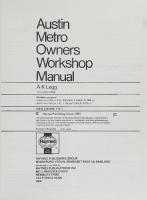
![Haynes Austin MG Metro 1980 to 1990 Owners Workshop Manual [1]
1850108110, 9781850108115](https://ebin.pub/img/200x200/haynes-austin-mg-metro-1980-to-1990-owners-workshop-manual-1-1850108110-9781850108115.jpg)
